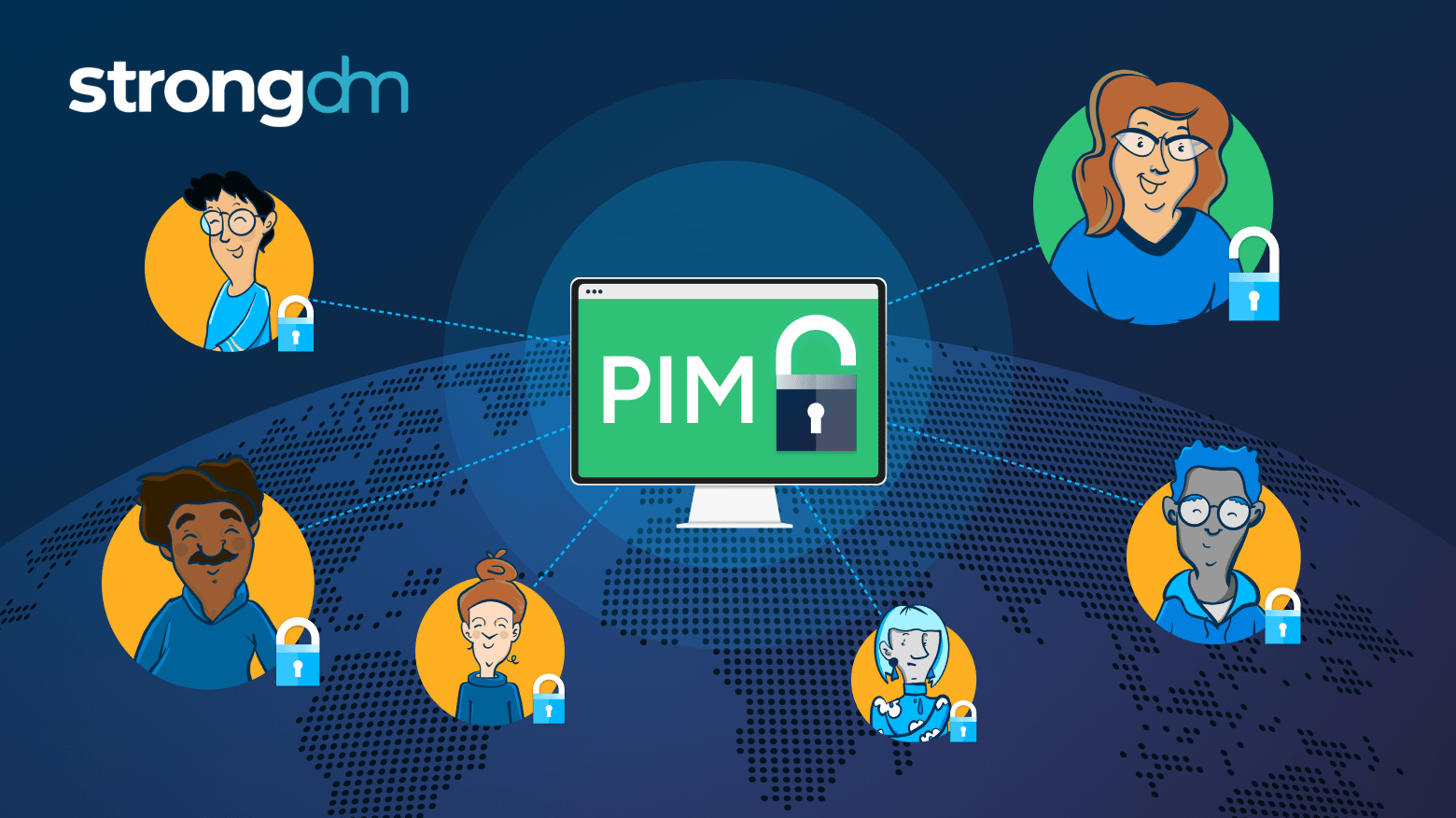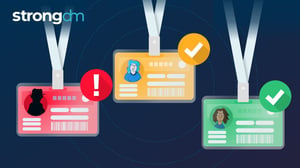
- Role-based, attribute-based, & just-in-time access to infrastructure
- Connect any person or service to any infrastructure, anywhere
- Logging like you've never seen

Cybercrimes are on the rise. These attacks are especially dangerous when they go after privileged accounts—those with access to your most critical systems and sensitive information.
Privileged Identity Management (PIM) is a complex cybersecurity approach. But it’s the only proven method you can use to lock down access and protect your precious resources. It can help you keep cybercriminals out and ensure that even your trusted users can’t accidentally—or intentionally—jeopardize your system’s security.
What Is Privileged Identity Management?
Privileged Identity Management (PIM) focuses on governing privileged identities—those accounts with elevated permissions that can access sensitive systems and data. PIM controls and monitors what both people and machines with elevated permissions can access.
You can use PIM to decide who can tweak system settings or alter important data. Also, you can monitor user activities to prevent admins from abusing their power or having too much access.
PIM vs. PAM vs. IAM
A comprehensive approach to securing access to critical systems and sensitive data requires the intersection of three methods — PAM, PIM, and IAM — each of which plays a vital yet unique role in an organization’s security strategy.
PIM vs PAM
People often use PIM and PAM interchangeably, but there are distinctions in what they achieve and how they do it.
PIM entails managing and controlling user identities with elevated permissions. Meanwhile, PAM regulates who can access specific systems, when they can access them, and under what conditions.
The primary difference between the two is that PIM focuses on the access a privileged account already has. PAM, however, deals with how to grant, monitor, and manage permissions whenever a user requests access to your systems or resources.
Think of PIM as managing the keys to a vault where you make sure only those with the right keys can get in. PAM, on the other hand, is like handling the process of issuing new keys and tracking who uses them.
PIM keeps an eye on who has access, while PAM manages how and when new access is granted.
PIM vs IAM
An IAM solution manages, authenticates, and controls user access to your organization's system and data. It applies broadly to all users in your company. PIM and PAM are subsets of IAM that only focus on privileged users — accounts with special permissions to configure apps, computer networks, or servers.
Why Is PIM Important?
According to Google's 2023 research, stolen and leaked credentials cause over 60% of cyber breaches in businesses. When hackers obtain logins of privileged accounts, they can steal critical information like:
- Trade secrets
- Financial records
- Customer credit card details
- Employees’ social security numbers
Through proper identity management and strict access control, PIM minimizes the risk of data theft and keeps sensitive information safe.
But PIM security policies don’t just fend off outside attacks—they also make sure your team only has the least access they need to do their jobs.
By following the principle of minimum access, PIM helps you keep tight control of who can get into crucial systems. This reduces the risk of insiders misusing or leaking sensitive data.
Safeguarding sensitive information helps you stay on top of data protection and privacy laws, such as:
- Health Insurance Portability and Accountability Act (HIPAA)
- General Data Protection Regulation (GDPR)
- Sarbanes-Oxley Act (SOX)
How Does PIM Work?
A privileged identity management tool connects a user directory—which contains privileged accounts, their existing permissions, and encrypted login information—to a resource management platform.
While recording every interaction (user session) in real time, the tool allows privileged users to access authorized company resources via a safe gateway.
Before granting access, the secure gateway verifies whether an account has permission to use a particular resource. If a user isn't authorized to utilize a resource or system, admins can grant that user temporary access.
PIM solutions have three key components and functionalities:
- Privileged account management: Safeguards and manages credentials for accessing privileged accounts to prevent unauthorized access.
- Session management: Monitors and records how authorized users interact with resources to detect threats in real time.
- Access control: Grants access to resources on a "need to know" and "need to do" basis to reduce the risk of security breaches.
Most PIM solutions have APIs and connectors for seamless integration with your IT infrastructure.
💡Make it easy: If you're looking to implement PIM, StrongDM can help you manage resources and privileged user identities in your company.
Types of Privileged Accounts
Privileged accounts fall into several categories based on the level of access and the type of resources they control:
- System accounts: Perform operating system tasks.
- Application accounts: Oversee, administer, and set up application software.
- Service accounts: Run tasks, including database and web processes.
- Root and admin accounts: Install and remove applications as well as change software configurations.
Examples of Privileged Identity Management
When it comes to implementing PIM solutions, you have several deployment options:
- On-premise PIM
- Cloud-based PIM
- Hybrid PIM
On-premise PIM
With on-premise PIM, you install and manage PIM solutions right in your own data centers. This gives you full control over your IT infrastructure and keeps sensitive data within your company’s walls.
Cloud-based PIM
If you choose cloud-based PIM, you set up your PIM tools on platforms like Azure, AWS, or Google Cloud—instead of in-house data centers. This makes your PIM solutions accessible from anywhere. Users can log in and verify their identity from wherever they are, as long as they have an internet connection. And even if you’re not in the office, you can still manage and keep an eye on their interactions with the system.
Hybrid PIM
Hybrid PIM lets you manage privileged access in the cloud and on-premise, giving you the best of both worlds.
Some PIM solutions are built only for in-house data centers and don’t play well with cloud environments. Others are cloud-based, while a few can handle any IT setup. So, it’s important to pick the right PIM technology that fits your specific needs.
💡Make it easy: A modern PIM solution like StrongDM works everywhere. You can implement it in in-house data centers and deploy it on any cloud network.
Privileged Identity Management Best Practices
Privileged Identity Management (PIM) protects sensitive data against cyber threats, but setting it up can be tricky.
The reason?
Finding the right balance between safeguarding sensitive data and giving people just enough access is often challenging. PIM best practices can simplify the process and make the management of privileged accounts more effective.
1. Conduct a thorough risk assessment
Figure out which of your systems and data are most critical and sensitive. Who has access to them and why?
With that information at your fingertips, it’s easy to spot potential security risks linked to privileged accounts. For example, you may discover that some users have way too much access to sensitive information. Others might have unauthorized access.
From there, you can put the right PIM access controls in place to reduce the risks of data leaks.
2. Establish clear policies and procedures
Define roles and responsibilities in your organization to establish who should have access to which resources and why. Then, set up role-based access control where you give each user system permissions they need for their jobs. At the same time, you revoke any unnecessary access.
Next, create a process for requesting and approving access. The goal is to verify each user's identity before allowing them to see critical data or use crucial IT infrastructure. That way, authorized users can easily get into your sensitive systems while unauthorized ones stay out.
3. Perform regular audits and compliance checks
Regulations like GDPR and HIPAA require you to keep track of what’s happening in your systems. To stay compliant, it’s a good idea to regularly inspect your systems. How?
Use a PIM technology that can create audit trails—real-time records of everything going on in your system. They document who’s doing what and when. As a result, you have a clear, verifiable log of activities that are essential in mandatory audits and legal investigations.
💡Make it easy: StrongDM’s audit logging tools are great for keeping track of system activities as they happen. They give you a clear, verifiable record that makes meeting auditing requirements a breeze.
4. Train and educate employees on PIM practices
Most security vulnerabilities in companies come from human error. By teaching your team about PIM best practices, you create cybersecurity awareness and build a culture that takes security seriously. This can help cut down on cyber incidents that happen because of simple mistakes like weak passwords and accidental data leakages.
5. Ensure continuous monitoring and improvement
Keep tabs on when users access your system and monitor their activities in real time. The idea is to continuously track their usual behavior. So when anything out of the ordinary happens that might signal a cyber attack, you can quickly spot it and take the necessary measures before it causes serious damage.
💡Make it easy: StrongDM’s logging tools give your IT team full visibility into your entire IT environment, making it easy to monitor and assess access patterns. It records every access attempt, so you can easily detect and swiftly respond to anything unusual.
6. Deploy a least-privilege approach
The principle of least privilege is about restricting user access to the minimum necessary to complete tasks. In other words, privileged accounts in your systems get the just-right access without disrupting workflow.
An example of the least privilege is the just-in-time (JIT) approach. JIT grants users access to resources only when they need it. This reduces the risks associated with unlimited access to resources and servers.
7. Implement multi-factor authentication (MFA)
Passwords alone aren’t always enough to keep cyber breaches at bay. That’s where multifactor authentication comes in. With MFA on every privileged account, users need to provide at least two pieces of evidence—like their password and a secret passcode—to prove they are who they say they are. So, even if hackers manage to crack a password, they still can't get into your critical systems and confidential data without clearing that second authentication step.
PIM technologies like StrongDM have multi-factor authentication as a security feature.
Steps To Develop a Comprehensive PIM Strategy
Create a PIM strategy in three simple steps:
- Assess current state: Identify who has access to what and why. What risks are associated with your privileged accounts? This information helps you understand your current security status and how to plan for the future.
- Define goals and objectives: Determine what you want to achieve from implementing PIM. Next, develop access policies that help reach your goals.
- Select the right PIM tool: Key features include a user-friendly interface, robust security features like MFA, and the ability to scale with your organization's growing demands.
Zero Trust PAM: The Future of PIM with StrongDM
With traditional PAM solutions, you control and manage privileged user permissions. But with a modern Zero Trust PAM from StrongDM, you make sure the right people have access to the resources they need exactly when they need them.
Additionally, you get complete visibility of your entire digital environment to enhance transparency. You also treat all users as privileged by consistently verifying their identity before granting any level of access. StrongDM's platform comes with built-in MFA as a standard security feature to add a layer of protection.
Ready to take privileged identity and access management to the next level? See how StrongDM helps you achieve Zero Trust and streamlines the management of access permissions.
About the Author
John Martinez, Technical Evangelist, has had a long 30+ year career in systems engineering and architecture, but has spent the last 13+ years working on the Cloud, and specifically, Cloud Security. He's currently the Technical Evangelist at StrongDM, taking the message of Zero Trust Privileged Access Management (PAM) to the world. As a practitioner, he architected and created cloud automation, DevOps, and security and compliance solutions at Netflix and Adobe. He worked closely with customers at Evident.io, where he was telling the world about how cloud security should be done at conferences, meetups and customer sessions. Before coming to StrongDM, he lead an innovations and solutions team at Palo Alto Networks, working across many of the company's security products.

You May Also Like




